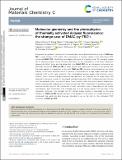Files in this item
Molecular geometry and the photophysics of thermally activated delayed fluorescence : the strange case of DMAC-py-TRZ
Item metadata
| dc.contributor.author | Crovini, Ettore | |
| dc.contributor.author | Dhali, Rama | |
| dc.contributor.author | Sun, Dianming | |
| dc.contributor.author | Matulaitis, Tomas | |
| dc.contributor.author | Comerford, Thomas | |
| dc.contributor.author | Slawin, Alexandra M. Z. | |
| dc.contributor.author | Sissa, Cristina | |
| dc.contributor.author | Azzolin, Francesco | |
| dc.contributor.author | Di Maiolo, Francesco | |
| dc.contributor.author | Painelli, Anna | |
| dc.contributor.author | Zysman-Colman, Eli | |
| dc.date.accessioned | 2023-05-19T12:30:02Z | |
| dc.date.available | 2023-05-19T12:30:02Z | |
| dc.date.issued | 2023-06-28 | |
| dc.identifier | 283737434 | |
| dc.identifier | 7eb55200-c5a4-4b1c-810e-5042aecb6281 | |
| dc.identifier | 85160576042 | |
| dc.identifier.citation | Crovini , E , Dhali , R , Sun , D , Matulaitis , T , Comerford , T , Slawin , A M Z , Sissa , C , Azzolin , F , Di Maiolo , F , Painelli , A & Zysman-Colman , E 2023 , ' Molecular geometry and the photophysics of thermally activated delayed fluorescence : the strange case of DMAC-py-TRZ ' , Journal of Materials Chemistry C , vol. 11 , no. 24 , pp. 8284-8292 . https://doi.org/10.1039/D2TC05213J | en |
| dc.identifier.issn | 2050-7526 | |
| dc.identifier.other | ORCID: /0000-0003-0470-7356/work/134055176 | |
| dc.identifier.other | ORCID: /0000-0002-9527-6418/work/134055887 | |
| dc.identifier.other | ORCID: /0000-0001-7183-6022/work/134056549 | |
| dc.identifier.uri | https://hdl.handle.net/10023/27649 | |
| dc.description | Funding: Authors thank EU Horizon 2020 Grant Agreement No. 812872 (TADFlife) for funding. The St Andrews team acknowledges support from the Engineering and Physical Sciences Research Council of the UK (grant EP/P010482/1). The authors from the University of Parma acknowledge the support from the HPC (High Performance Computing) facility of the University of Parma, Italy. Moreover, authors from University of Parma benefited from the equipment and support of the COMP-HUB Initiative, funded by the “Departments of Excellence” program of the Italian Ministry for Education, University and Research (MIUR, 2018-2022). | en |
| dc.description.abstract | We present the synthesis, optoelectronic characterization, and a detailed theoretical study of DMAC-py-TRZ, a novel, efficient TADF emitter. This compound is a structural relative of the well-known TADF compound DMAC-TRZ, substituting the bridging phenylene for a pyridyl group. This marginal change has an enormous impact on the structure and hence on the photophysics as the steric interactions between the DMAC donor and the bridge that force DMAC-TRZ into an orthogonal conformation are attenuated and permit DMAC-py-TRZ to adopt a planar and slightly bent structure in the ground state. The large degree of conjugation in the bent DMAC-py-TRZ structure, demonstrated by the strong intensity of the lowest excitation with CT character, is responsible for a large singlet triplet gap, hence hindering TADF of this bent conformer. The computational analysis predicts that emission occurs, however, from a relaxed orthogonal excited-state geometry, as confirmed by the huge Stokes shift observed in non-polar solvents. In this relaxed orthogonal geometry TADF is indeed observed. Emission from the unrelaxed state is recovered in glassy frozen solvents, where the emission band is largely blue-shifted compared with measurements in liquid solvent, and TADF is quenched. In amorphous matrices, structural disorder leads to the coexistence of both conformers, even if, depending on the emitter concentration, dual fluorescence may disappear due to a fast energy transfer from the bent to the orthogonal conformers. We maintain that this efficient energy transfer is responsible for the good efficiency of DMAC-py-TRZ devices, because of the presence in the matrix of a sizable proportion of compounds that adopt the bent structure, favorable to act as the host for the orthogonal TADF conformer of DMAC-py-TRZ. | |
| dc.format.extent | 9 | |
| dc.format.extent | 1686784 | |
| dc.language.iso | eng | |
| dc.relation.ispartof | Journal of Materials Chemistry C | en |
| dc.subject | QD Chemistry | en |
| dc.subject | DAS | en |
| dc.subject | MCC | en |
| dc.subject.lcc | QD | en |
| dc.title | Molecular geometry and the photophysics of thermally activated delayed fluorescence : the strange case of DMAC-py-TRZ | en |
| dc.type | Journal article | en |
| dc.contributor.sponsor | European Commission | en |
| dc.contributor.sponsor | EPSRC | en |
| dc.contributor.institution | University of St Andrews. School of Chemistry | en |
| dc.contributor.institution | University of St Andrews. Institute of Behavioural and Neural Sciences | en |
| dc.contributor.institution | University of St Andrews. EaSTCHEM | en |
| dc.contributor.institution | University of St Andrews. Centre for Energy Ethics | en |
| dc.identifier.doi | https://doi.org/10.1039/D2TC05213J | |
| dc.description.status | Peer reviewed | en |
| dc.identifier.grantnumber | 812872 | en |
| dc.identifier.grantnumber | EP/P010482/1 | en |
This item appears in the following Collection(s)
Items in the St Andrews Research Repository are protected by copyright, with all rights reserved, unless otherwise indicated.

